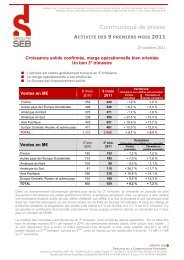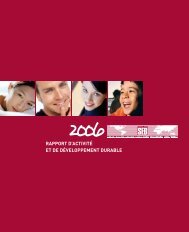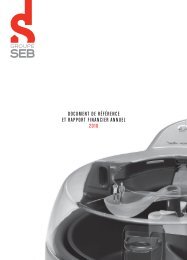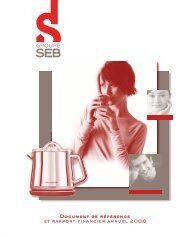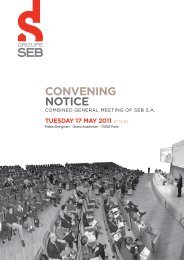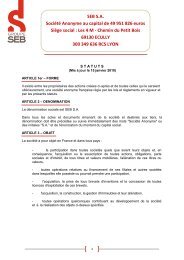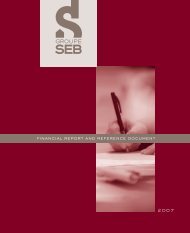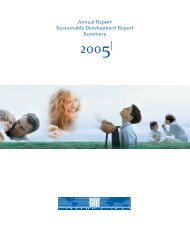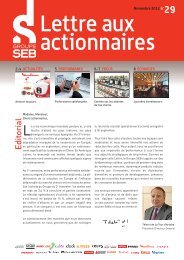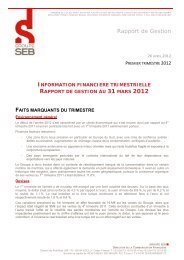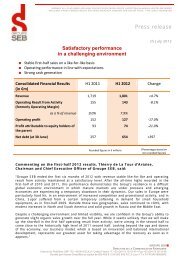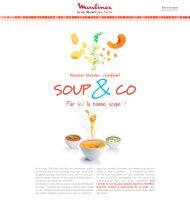financial report and registration document 2011 - Groupe SEB
financial report and registration document 2011 - Groupe SEB
financial report and registration document 2011 - Groupe SEB
You also want an ePaper? Increase the reach of your titles
YUMPU automatically turns print PDFs into web optimized ePapers that Google loves.
4 Commentary<br />
Commentary on the fi nancial year<br />
on the consolidated results<br />
4.3. COMMENTARY ON THE CONSOLIDATED<br />
RESULTS<br />
Income statement<br />
At €453 million, <strong>Groupe</strong> <strong>SEB</strong>’s <strong>2011</strong> operating result from activity (formerly<br />
referred to as operating margin) was up 3.5% compared with 2010, a year<br />
that had set the bar high at €438 million, up 23% over 2009. This fi gure<br />
represents 11.4% of sales (12% in 2010 <strong>and</strong> 11.2% on 2009). This drop,<br />
which was largely anticipated, is mainly due to the geographical mix of sales;<br />
operating margin from activity, as a percentage of sales, is lower in emerging<br />
markets than in mature markets. Thus, the fact that the emerging markets<br />
represent an increasingly greater share of the consolidated sales dilutes the<br />
operating margin across the Group.<br />
However, operating result from activity is increasing in terms of value. This<br />
positive change is linked to a set of factors, whose mixed effects were<br />
ultimately positive:<br />
� sustained consumer spending levels, in general, despite the crisis<br />
confi rmed in certain countries <strong>and</strong> the slowdown observed in certain<br />
regions from the summer, as well as gains in market share, resulted in<br />
an increase in volumes sold, supported by strong industrial production<br />
levels <strong>and</strong> satisfactory absorption of costs. The trend was not, however,<br />
as marked as in 2010 (effect of over €150 million), which benefi ted from a<br />
very sharp upswing in industrial activity after 2009’s worldwide economic<br />
crisis. The impact of volume on the <strong>2011</strong> operating result from activity<br />
amounts to +€76 million;<br />
� the impact of the price mix amounts to a negative -€32 million, with a<br />
certain stabilisation apparent after the negative impact of -€27 million<br />
during the fi rst half of the year. The causes of this decrease include a<br />
proliferation of promotional operations <strong>and</strong> price adjustments in certain<br />
markets, which also cancelled out the effect of the targeted price increases<br />
applied. It also refl ects the dilutive effect that the strong sales dynamic in<br />
emerging economies had on the mix;<br />
� a €59 million increase in purchasing costs in relation to 2010, due to higher<br />
costs of raw materials (metals <strong>and</strong> plastics) <strong>and</strong> sourced products. This<br />
anticipated increase could not be offset by a positive currency effect of<br />
€26 million, which includes the positive impact that the <strong>2011</strong> dollar/euro<br />
exchange rate – on average below that of 2010 – had on procurement;<br />
� the slight increase in intervention costs was due mainly to greater<br />
investments in innovation (€130 million, including strategic marketing<br />
<strong>and</strong> R&D) <strong>and</strong> commercial resources (including the development of<br />
the Group’s own retail br<strong>and</strong> outlets). Such investments are crucial to<br />
supporting its product dynamic <strong>and</strong> continuously improving product<br />
exposure on store shelves <strong>and</strong> marketing within stores. Overheads were<br />
contained <strong>and</strong> benefi ted from continuous progress in after-sales service<br />
<strong>and</strong> further reductions in warehousing costs (on a like-for-like basis). After<br />
2010, which was marked by massive spending on advertising (€143 million<br />
versus €95 million in 2009) in a buoyant <strong>and</strong> receptive market situation, the<br />
more complicated economic climate of <strong>2011</strong> led the Group to reduce its<br />
commitments in this area. Thus, although advertising spending remained<br />
high during the fi rst half of the year in order to support the relaunch of<br />
Moulinex, it fell, especially in the fourth quarter. Moreover, this quarter is<br />
compared against the fourth quarter of 2010, an extremely active period<br />
in terms of advertising. In the end, the Group allocated €128 million to its<br />
advertising budget in <strong>2011</strong>, representing 3.2% of sales.<br />
In addition, operating result from activity benefi ted from a change in scope<br />
<strong>and</strong> from a €5 million contribution from the newly acquired companies,<br />
Imusa, consolidated since 1 March, <strong>and</strong> Asia Fan, consolidated since 1 June.<br />
Operating profi t climbed from €349 million in 2010 (9.6% of sales) to<br />
€400 million in <strong>2011</strong> (10.1% of sales). This increase – almost 15% – greatly<br />
exceeds the growth seen in operating result from activity. This was due, in<br />
part, to lower bonus <strong>and</strong> profi t-sharing payments than in 2010 (€44 million in<br />
<strong>2011</strong> versus €50 million in 2010), resulting from the fact that the exceptional<br />
performance witnessed in France in 2010 did not repeat itself. It is also<br />
related to a much lower liability for “other income <strong>and</strong> expenses” than in<br />
2010, i.e. -€9 million versus -€38.5 million. This amount includes:<br />
� provisions for restructuring costs limited to €6 million (€15 million in 2010)<br />
<strong>and</strong> comprising several small-scale transactions;<br />
� impairment losses that were also lower (€13 million in <strong>2011</strong> vs. €18 million<br />
in 2010), representing restatements concerning plants <strong>and</strong>, given the<br />
uncertainties in 2012, additional impairment of All-Clad’s goodwill (in the<br />
amount of €7 million), as All-Clad’s recovery may prove precarious in such<br />
a challenging economic climate;<br />
� other items including a capital gain on the sale of l<strong>and</strong> in Brazil representing<br />
€14 million. This sale had been in the pipeline for a long time, but was<br />
fi nalised at the beginning of the year, under favourable conditions including<br />
real estate appreciation <strong>and</strong> the strengthening of the Brazilian real.<br />
Net fi nancial expense amounted to -€27 million, compared with -€16 million<br />
in 2010. This increase, essentially the result of greater interest expenses, is<br />
based on two factors. The fi rst of these factors is the increase in average debt<br />
– although this fi gure remains at moderate levels (going from €195 million<br />
68 GROUPE <strong>SEB</strong> Financial Report <strong>and</strong> Registration Document <strong>2011</strong>



